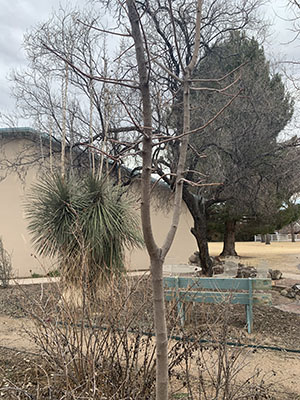February 22, 2020
When To Prune
Question:
When is the right time to prune ornamental and fruit trees?
- Weary gardeners across the state
Answer:
Well, you’re not going to be surprised at this answer: It just depends.
What are your reasons for pruning? Are your trees grown for their beautiful blooms? If so, do they bloom before leaves start to appear? Trees like redbuds and crabapples and shrubs like lilac and forsythia flower before they leaf out, and that’s a clue that the flowers emerge from buds growing on older growth. If you prune too much you’ll lose out on this season’s flush of color. It makes more sense to prune those just after they’ve bloomed.
On the other hand, if you're wanting to reduce the growth of a young tree because branches are getting awfully close to your gutter, pruning midsummer might make more sense than pruning in late February. As Dr. Ed Gilman explains in his wonderful book An Illustrated Guide to Pruning, "To retard growth and for a maximum dwarfing effect on all trees, prune just after each growth flush, when the leaves have fully expanded and turned dark green. Pruning at this time theoretically slows growth by reducing photosynthetic capacity and energy-storing wood (sapwood), which causes a dwarfing effect. Only healthy, vigorous, young or medium-aged trees should be pruned using this strategy. Pruning live branches from unhealthy old trees, including those impacted by construction activities, at a time of low energy reserves, during or just after the growth flush, could deplete them further of much-needed energy reserves and energy-producing tissue (i.e., leaves)." You might also consider moving that young tree to a better spot before it's too big and gets more difficult to move. "Right tree for the right place" is an Arbor Day Foundation mantra that is simple, yet bears repeating because we mess this one up. A lot.
Pruning during dormancy triggers a greater flush of new growth once the season kicks off in spring. That's one reason pruning is so important for increasing potential fruit and nut yields. Gilman again: "To encourage the greatest total growth when pruning deciduous and semi-evergreen plants, prune during the dormant period."
For more on pruning apple, pear, cherry, plum, and peach trees, check out our NMSU Extension Guide: H-327: Pruning the Home Orchard.
Are your trees newly planted? There are pros and cons to pruning at the time of planting. One pro is that the smaller the branch diameter the better because it'll take less energy for the tree to seal a smaller wound. At last year's annual Valencia County Extension pruning workshop, Joran Viers, City Forester for the City of Albuquerque, said, "Pruning is an exercise in imagining the future." If you can identify a branch or two that will eventually need to be pruned out, it's better to do it while that branch is smaller. And it can be way easier to reach and do a proper cut by leaning a potted tree on its side to prune before it even goes in the ground.

However, in the weeks and months after planting, we want the roots to take hold first. So that means being patient with your new tree and understanding that slow growth above ground may just mean the roots are doing great and the canopy will catch up later in the season, or next year. Many arborists and researchers recommend pruning as little aboveground tissue as possible at the time of planting to discourage canopy growth and encourage root establishment in that first season.
Remember, pruning injures trees, so if you can avoid pruning altogether, that’s preferable. Trees that are grown directly from seed and planted in the right location may never need pruning. At Think Trees New Mexico’s 33rd annual conference in 2019, keynote speaker Denise Britton, consulting arborist from California, stated, “Trees don’t need pruning. Pruning is for people,” which prompted several arborists in the packed conference room to break out in applause. Most ornamental and fruit trees are pruned in the nursery, and that interrupts their natural growth form, so we have to make pruning decisions throughout the life of the tree. Plus, many fruit trees have been bred for production more than branching structure, so pruning may be required in order to support the fruit load.
Here are some reasons pruning workshops are commonly scheduled in the late winter months:
-
If we prune fruit trees in the middle of summer, we’re pruning out fruit that are already getting established, and those resources are lost.
-
It’s easier to see the branching structure on deciduous trees when they’re dormant.
-
There’s already so much other work to do in our gardens and orchards during the growing season.
No matter what time of year, it’s always a good time to prune out damaged, dangerous, or dead branches—it’s much easier to find dead branches when the rest of the tree is covered in leaves. For links to more resources, including pruning videos by Dr. Gilman, visit Desert Blooms.
Marisa Y. Thompson, PhD, is the Extension Horticulture Specialist, in the Department of Extension Plant Sciences at the New Mexico State University Los Lunas Agricultural Science Center, email: desertblooms@nmsu.edu, office: 505-865-7340, ext. 113.
Links:
For more gardening information, visit the NMSU Extension Horticulture page at Desert Blooms and the NMSU Horticulture Publications page.
Send gardening questions to Southwest Yard and Garden - Attn: Dr. Marisa Thompson at desertblooms@nmsu.edu, or at the Desert Blooms Facebook page.
Please copy your County Extension Agent and indicate your county of residence when you submit your question!